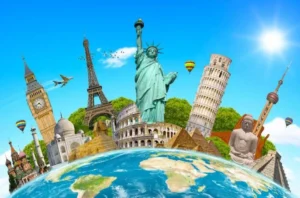What is Food and Beverage Industry?
The foodservice industry engages itself in the provision of food and beverages, mainly to people who are away from their homes for different reasons.
Such people need accommodation with food and beverages if they are away for more than a day and only food and beverages if they are away for a short duration of time.
What is the History of the Food and Beverage Industry
During those days, people took shelter under trees when they were away from their homes and depended on natural sources for their food. Their lives were endangered by wild animals and wayside robbers, which forced them to look for a place that assured them safety, accommodation, and food. Dharamshala and Chatrams came up to protect the lives of travelers from wild animals and from robbers.
These were buildings where travelers could stay free of cost. The travelers were also provided stables and shed for horses and bullock carts, respectively, free of charge. They were given food and accommodation at no cost during the rule of kings.
Mighty regional kings entertained common people and merchants with feasts consisting of a variety of rich dishes, Traditional dances, Bravery arts, etc, during festivals. The country was able to absorb the impact of these instructions because it was able to assimilate and tolerate foreign ideas and people.
The outsiders who came to India during the course of its history include the Greeks under Alexander the Great, the Khushãnas from Central Asia, the Mongols under Genghis Khan, Muslim traders, and invaders from the Middle East and Central Asia, and finally the British and other Europeans.
It was during the Mughal rule that “Sarais“ was developed to provide accommodation to travelers which were later converted to inns and western-style hotels during the British rule. The invasion by other dynasties brought their cultures and cuisines to the land.
The people of India, in general, did not prefer dining out till the early 1960s. They always carried with them homemade food to the workplace, school, and while traveling. Even today, some people carry food whenever they go out.
In South India, people used to buy packed food such as lime rice, tamarind rice, and curd rice from food vendors. In the north, Bhojanalayas served local dishes, especially roti, sabzi, and salad.
Most restaurants of the 1960s were not much concerned about food and personal hygiene or serving food at the right temperature.
Limited items were prepared beforehand, displayed on the shelves, and served till the stock got exhausted. The people who reached early got hot food and those who come late would get cold food.
The attitude of the restaurateur or mess keeper took it or leave it and people had no option but to have what was being given. Coal or firewood was used for cooking. Only the higher-end hotels and restaurants had the luxury of cooking with gas.
The development of catering is mainly attributed to the British, who introduced hotels and restaurants similar to the ones in Europe. They also established resorts in hill stations.
This led to the establishment of small lodges and restaurants in and around railway stations to cater to the needs of travelers. Refreshment rooms at railway stations and pantry cars in some of the trains were introduced.
Reputed hotels such as the Taj, the Oberoi, and the Ambassador were well established when India became independent. After independence, the hospitality industry grew at a faster rate.
As economic activities augmented, numerous eateries and hotels of different styles and sizes were established, which catered to the requirements of travelers and the general public.
India Tourism Development Corporation (ITDC) was set up in October 1996 with the objective of developing and expanding the tourism infrastructure in the country and thereby promoting India as a tourist destination.
ITDC succeeded in achieving its objectives by promoting the largest hotel chain in India and providing all tourist services such as accommodation, catering, transport, in-house travel agency, duty-free shopping, entertainment, publicity, consultancy, and so on, under a single window.
It also offered consultancy services from concept to commissioning in the tourism field for private organizations.
Why the Food and Beverage Industry is Important
The basic needs of customers for food and beverages are met by the foodservice industry, which has been associated with lodging ever since people started traveling.
People who move out of their houses for various reasons, such as jobs, education, business, leisure, medical treatment, sports, religion, and so on, depend completely on the foodservice industry for their meals.
Introduction to Food and Beverage Industry
The food and beverage industry in India traces its roots to the traditional community feasts and the movement of people on pilgrimage thousands of years ago. Most people were on the move primarily for preaching religion and hunting.
During those days, people took shelter under trees when they were away from their homes and depended on natural sources for their food.
The barter system of the transaction was slowly introduced and this system motivated people to travel for trade, mainly of livestock, which later expanded to food grains, clothing, tools, and other goods. The sectors of foodservice continually change their style of operation to meet the changing needs of the customers.
The Overview of the Food and Beverage Industry
Foodservice operations may vary in size, style, location, and the market they are catering to. From a wayside tea stall to an exclusive fine dining restaurant of a deluxe hotel, and from mid-day meal services for school children to meals for industrial workers, all come under the fold of the F&B sector.
It is necessary to classify all the F&B sectors for a better understanding of their operations. The Food and beverage sector can broadly be classified into the following two groups according to the priority given to the provision of food and beverages,
1. Secondary Catering Sectors
Examples are food service outlets in the accommodation sector, various types of restaurants, and takeaways. The establishments in which the provision of food and beverages is not the main activity but a secondary or support activity are called secondary catering sectors.
The primary activity of these units is not the provision of food and beverages to the clients but the activity for which it is set up.
2. Commercial sectors
Commercial sectors operate mainly to make a profit or to earn an adequate return on investment through their products and services.
Food and beverage facilities of hotels, resorts, motels, clubs, stand-alone restaurants, popular restaurants, takeaway outlets, pubs and bars, coffee shops, fast food outlets, transport catering, contract catering of industries, and so on, are examples of commercial catering.
Other than accommodation, Hotels provide Food and Beverage services to customers in the following areas:
Most guests staying in hotels are on business trips and stay for a very short duration and expect quick service. They may also need banquet halls to hold functions, conferences, and business meetings.
The restaurants of hotels may offer a buffet for all three meals to speed up service. Food and beverage service may also be extended to guests who are not staying in the hotel.
The ambiance of the restaurant will be very informal and the service is either from a buffet or at the table. Guests expect special dishes from the region as they want to experience new dishes and have more time to spend in the restaurant.
Motels provide Food and beverage facilities to travelers. Food can either be consumed in the restaurant or taken away. Clubs offer food and beverage services only to their members. The governing body of the club is responsible for monitoring the catering services, which may either be run by a contractor or by the employees of the club.
Welfare sectors operate mainly to provide services at no profit and no loss basis and most of them are run by private bodies or the Government. They operate within their outlined budget for the provision of food and beverage services.
If the catering services are given away on contract, then the motive of the contractor would be to make a profit, and hence such services will become commercial operations.
Most of these sectors are outsourced these days as managements want to concreate on their primary activities. The services rendered to patients are charged. Medical staff, outpatients, and visitors make use of the cafeteria facilities.
Conclusion
All sectors of the food and beverage service industry in a major way. The prospects for catering look great because in the future also people, whether at home or at their workplace, will be dining out.
The number of people availing of the services of the food industry is steadily increasing due to their increased disposable income.
The food and beverage service industry is different from other industries in satisfying the needs of customers. It satisfies one of the most important physiological needs of the consumers, that is, hunger and thirst. The need is satisfied for a very short period of time, after which that physiological need arises again and has to be met.
With globalization, faster communication, and transportation, improvement in food processing technology, catering education in India, changing food habits, increased number of an educated population and working class, and positive government policies, the foodservice industry in our country is poised for a major expansion.
Foodservice professionals must understand the internal and external environment and make use of the opportunity.
Read next:




